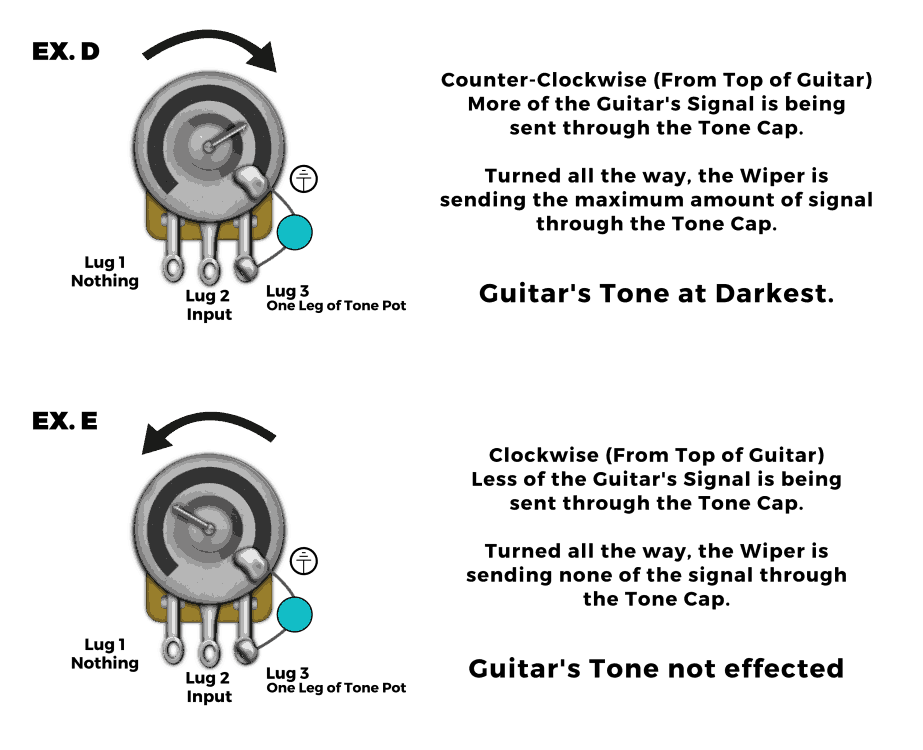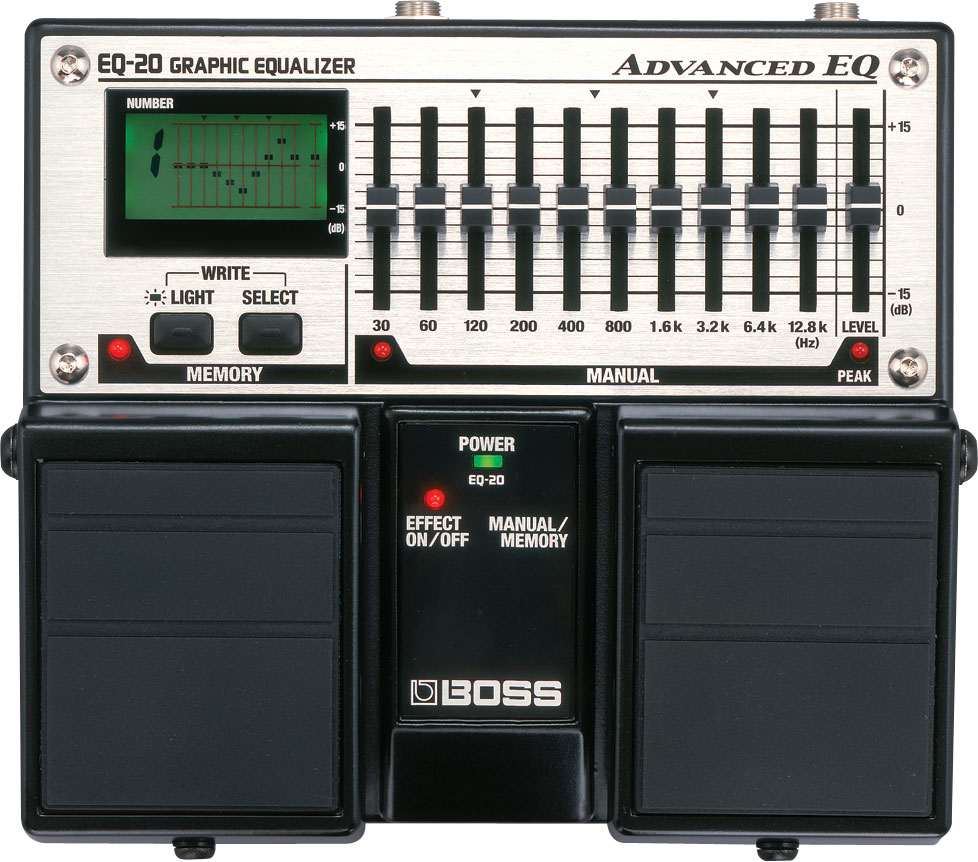-
My Tone Pot dilemma is when I turn the Tone pot to remove the high treble frequencies, the volume on the high treble strings get lower.
How do I increase the volume on the treble strings and remove the high treble frequencies?
Volume Pots & Tone Pots: How Do They Work? | Fralin Pickups
1. You turn your Tone Pot counter-clockwise.
2. Your signal starts to pass through the Tone Cap, which connects to ground. (Example D).
2. The Tone Cap will reject the low frequencies, allowing the high frequencies to get sent to ground, thus making your tone sound darker.

-
03-11-2023 06:05 AM
-
Google "modern wiring" vs "50s wiring".
-
Yes, I tried Modern wiring, but when I turn the Tone pot to remove the high treble frequencies, some treble string volume is lost. Not surprising, as I am cutting the high frequencies in the signal, but how do I compensate for this?
 Originally Posted by JCat
Originally Posted by JCat
'50s Wiring vs Modern Wiring...What's the deal? | Fralin Pickups
Pros of Modern Wiring:
- The Tone Pot will not affect your pickup’s volume.
-
The only method I know to achieve this is to use a wide band EQ and boost the volume of the frequencies I want to hear.



-
It's tricky sometimes. My best advice:
Adjust your pickups: If you want more volume on the treble side then slant the pickup so that it's higher on the treble side. Also when there are adjustable pole screws; raise the poles for the strings you like to be louder.
Adjust your amp: Avoid scoping out the mids. If you got lots of bass and treble but no mid range, it's very hard to get a good consistent sound across the full range of the guitar. Try to lower the bass, turn up amp treble and roll back guitar tone. Also roll back guitar volume and increase amp volume.
Check your pedal board and cables: Try a longer (higher capacitance) instrument cable. It will reduce treble all by itself and you could turn guitar tone up again. Unplug your pedals and compare the tone straight from your guitar. Avoid buffered pedals that color the tone in stand by.
Compare a different speaker. An EQ pedal could possibly be the ticket if nothing else is working.
-
My 1950 ES-125 with its 50ies wiring does great in this aspect: yes, contols are very interactive so turning down treble means upping the volume to compensate. Turning down volume on the other hand does not yield loss of treble.
I tried 50ies wiring in my other guitars but did not manage to get the same result as with my ES-125 (I blamr that to modern log pots having a different taper as in the 50ies).
After some experimenting I found that with modern log pots (I use Alphas) the modern wiring with a treble bleed mimics the behaviour of my ES-125 the best (pretty ironic that the 50ies circuit does not…..).
-
The best way IMO to compensate for loss of treble via the tone pot is to angle the pickup to that it gives greater output on the treble side - ie raise the treble side, lower the bass side. I find this much more effective than any form of eq; the fundamental notes of the high E and B strings are down in the midrange area of 2/300 hz., and most eqs don't have the very narrow bands you'd need to boost the top string fundamentals without also boosting the midrange. Also, most pedals and other eq devices have a nasty habit of thinning the tone anyway, due to impedance mismatch.
I think the differences between modern and 50s wiring are somewhat overstated.
oops didn't notice that pickup adjustment was already mentioned...must read previous posts...To be a bit more specific, adjusting the treble side to ( eg) 3mm below strings, and the bass side to say 6mm below, will make an appreciable difference to the relative volumes, enough to compensate for some treble roll-off.
Another idea is to use an Alnico 3 pickup magnet, which results in much softer trebles whilst maintain the top string volume. This works in HBs and P90s.Last edited by Franz 1997; 03-12-2023 at 01:18 PM.
-
As mentioned tilt pickup with the treble side up, also google Herb Ellis polepieces adjustment.
Also mentioned, having a healthy amount of midrange and upper midrange is important to retain volume and body on treble strings.
On Fender amps the treble control affects both high mids and treble. Also on Fenders the mids are scooped when set to 5 - 5, my starting point is often something like bass 3, treble 4, guitar tone 7. Sometimes reducing the bass will bring out the mids.
Scooped speaker can add to the problem.
Popular string gauges for jazz are heavy top lighter bottom, which also helps to give some weight to the treble strings.
Tone cap size. If your guitar has 044, try 022 or 015, that would retain more mids while cutting treble the same amount.
Mid-scooped or a bright pickup can be another.
Pickup to string distance has an effect on tone, experiment with that too.
Thinner picks can have a brighter more scooped sound.
That is a lot of things to consider, but each is a piece of the puzzle.
The wiring or pot taper were never a problem for me in terms of string to string balance though.
-
I think you have this backwards. The higher the tone cap value, the less bright the tone will be. And tone caps do not “retain” more mids except for a very slight and narrow midrange bump with some circuit designs. The higher the rating, the darker the tone. So the tone will be darker (ie less bright) with a 0.044 uF cap than a 0.022 or less.
 Originally Posted by burchyk
Originally Posted by burchyk
-
Yup!
 Originally Posted by nevershouldhavesoldit
Originally Posted by nevershouldhavesoldit
And let’s not forget that with the pot full open the cap is not in the circuit and has no influence on the sound. I mention this because I have heared guitar players hyping about their bumblebee caps and then mention they always play with their pots wide open…..
I put a .1 cap in my Strat. With the pot fully closed, the tone is not really useable (too dark), but the ‘taper’ or the gradient reduction of treble of the pot became much more practical for me.
-
I don't think any guitar, with any pot, and any cap, is really usable with the tone control fully closed. At least I've never played or heard one that is.
-
I'd be asking, why do the manufacturers use that value capacitor and tone pot, if fully on is too dark to be usable.
 Originally Posted by sgosnell
Originally Posted by sgosnell

-
What is unusable to me might well be usable to someone else. Good tone is purely a matter of taste. And tradition must always be considered when discussing jazz guitars.
-
Metheny said in an interview that he uses the whole range of the tone control depending on context.
-
We're saying basically the same thing regarding the capacitance value being inverse proportional to the corner frequency, not opposite.
 Originally Posted by nevershouldhavesoldit
Originally Posted by nevershouldhavesoldit
Smaller values affect midrange less than higher values on a classic guitar tone control.




 Reply With Quote
Reply With Quote







Just Friends -- or keeping things simple
Today, 12:04 AM in Improvisation